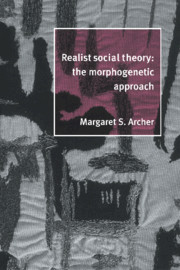Book contents
- Frontmatter
- Contents
- List of figures
- Acknowledgements
- 1 The vexatious fact of society
- Part I The problems of structure and agency: four alternative solutions
- Part II The morphogenetic cycle
- 6 Analytical dualism: the basis of the morphogenetic approach
- 7 Structural and cultural conditioning
- 8 The Morphogenesis of agency
- 9 Social elaboration
- Index
7 - Structural and cultural conditioning
Published online by Cambridge University Press: 02 December 2009
- Frontmatter
- Contents
- List of figures
- Acknowledgements
- 1 The vexatious fact of society
- Part I The problems of structure and agency: four alternative solutions
- Part II The morphogenetic cycle
- 6 Analytical dualism: the basis of the morphogenetic approach
- 7 Structural and cultural conditioning
- 8 The Morphogenesis of agency
- 9 Social elaboration
- Index
Summary
The Realist is committed to maintaining that the ‘causal power of social forms is mediated through social agency’. This commitment protects against reiflcation and endorses the view that agents are the only efficient causes in social life. Nevertheless, agents are not exhaustive of social reality, since both material and ideational emergent properties (SEPs and CEPs) exist and are the bearers of causal powers. There seems to be a difficulty with the preceding sentences. They assert the existence of two kinds of entities and of two kinds of causal powers – those of the ‘parts’ and those of the ‘people’ – yet allow that only the latter can be responsible for efficient causality. This raises a duo of important questions, namely, ‘why this difference between them?’, and, if there is such a difference, then ‘how can structure and culture be influential at all’ – since it is not reducible to people who are the only efficient causes? Structural and cultural conditioning it will be maintained are quintessentially matters of mediation, and the first phase of the morphogenetic cycle is therefore concerned with mediatory processes.
Mediation through human agency
In open systems, emergent properties (SEPs and CEPs) can exist unexercised due to a variety of intervening contingencies. The one factor which guarantees that social systems remain open (and even precludes thought experiments about closure), is that they are necessarily peopled.
People, in turn, are capable of resisting, repudiating, suspending or circumventing structural and cultural tendencies, in ways which are unpredictable because of their creative powers as human beings.
- Type
- Chapter
- Information
- Realist Social TheoryThe Morphogenetic Approach, pp. 195 - 246Publisher: Cambridge University PressPrint publication year: 1995



